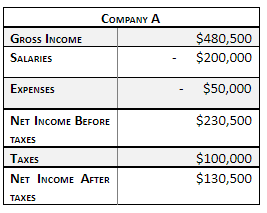Content

Two of the most common, and effective, ways to do so are horizontal analysis and vertical analysis. Horizontal analysis is used in financial statement analysis to compare historical data, such as ratios or line items, over a number of accounting periods. Also referred to as trend analysis, this is the comparison of financial information such as net income or cost of goods sold between two financial quarters including quarters, months or years. Often expressed in percentages or monetary terms, it provides insights into factors that significantly affect the profitability of an organization. For instance, in the year 2015, organization A had 4 million turnover as compared to year the 2014 whereby the turnover was 2 million. The 2 million increase in turnover is a positive indication in terms of performance with a 50% increase from the year 2014.
Financial statement analysis, also known as financial analysis, is the process of understanding the risk and profitability of a company through the analysis of that company’s reported financial information. This information includes annual and quarterly reports, such as income statements, balance sheets, and statements of cash flows.
How Vertical Analysis Works
For example, each line of an income statement represents a percentage of gross sales, while each line of a cash flow statement represents each cash inflow or outflow as a percentage of total cash flows. Vertical analysis is used to show the relative size of each item line of the income statement and the balance sheet.
Microservice Architecture Market Insights Updates Duct Fans Market Forecast and Analysis as Corona Virus Outbreak Disturbs Investment Plans – mainlander.nz – mainlander.nz
Microservice Architecture Market Insights Updates Duct Fans Market Forecast and Analysis as Corona Virus Outbreak Disturbs Investment Plans – mainlander.nz.
Posted: Wed, 22 Dec 2021 18:24:57 GMT [source]
For each account on the income statement, we divide the given number by the company’s sales for that year. The above vertical analysis example shows the net profit of the company where we can see the net profit in both amount and percentage. Where the income statement can be compared with previous years, and the net income can be compared where it helps to compare and understand the percentage of rising or loss of income percentage. In this example, you can quickly see that while total sales increased in year two, the company’s gross and net profit percentage decreased. While you would likely expect the cost of goods sold to increase as the total sales amount increases, using the vertical analysis method reveals that the costs didn’t increase proportionately to the increase in sales. Vertical analysis is a top to bottom analysis of income statement where amounts for all line items in the income statement are converted to a percentage of a base amount . This analysis is done to see the relative size of each type of income or expense with respect to the revenue .
Relationship Between Total Asset Turnover & Capital Intensity Ratio
For the current year, they suddenly jump to say 50%, this is something that management should check. In the above table, it can be seen that thegross profit margin has remained fairly stable during the last two years, while the operating margin has witnessed a slight improvement in 2018 due to a decrease in SG&A expense. The net income margin also improved in line with the operating income margin.
Vertical Hollow Shaft (VHS) Motor Market 2021 Size, Share, Growth Opportunities with Key Player Analysis (GE, Nidec, Kirloskar Electric, Toshiba) https://t.co/htCHPhCzRh
— PHedge (@politicalHEDGE) December 15, 2021
Particularly, interlinks among the numbers make financial analysis tiresome and complex for a typical businessperson. A solution is to create Comparative Financial Statements, which depicts the results of Horizontal Analysis and show the trends relative to only one base year. The baseline acts as a peg for the other figures while calculating percentages. For example, in this illustration, the year 2012 is chosen as a representative year of the firm’s activity and is therefore chosen as the base.
Financial Statement Analysis
By doing this, we’ll build a new income statement that shows each account as a percentage of the sales for that year. As an example, in year one we’ll divide the company’s “Salaries” expense, $95,000 by its sales for that year, $400,000. That result, 24%, will appear on the vertical analysis table beside Salaries for year one. For the balance sheet, the total assets of the company will show as 100%, with all the other accounts on both the assets and liabilities sides showing as a percentage of the total assets number. This method is easy to compare with the previous reports and easy to prepare.
How does horizontal look like?
A horizontal line is one which runs left-to-right across the page. In geometry, a horizontal line is one which runs from left to right across the page. It comes from the word ‘horizon’, in the sense that horizontal lines are parallel to the horizon. … A vertical line is perpendicular to a horizontal line.
While vertical analysis looks at the components of income statements and their relative size, horizontal analysis looks at changes in the financial statements over a period of time. Usually, it is the total asset, but one also can use total liabilities for calculating the percentage of all liability line items. Such an analysis helps in evaluating the changes in the working capital and fixed assets over time. Investigating these changes could help an analyst know if the company is shifting to a different business model. Vertical Analysis is one of the financial analysis methods with the other two being Horizontal Analysis and Ratio Analysis.
Horizontal Company Financial Statement Analysis
Vertical analysis shows all items of an income statement as a percentage of gross sales and all items on a balance sheet as a percentage of total assets. Horizontal analysis refers to the comparison of financial information such as net income or cost of goods sold between two financial quarters including quarters, months or years. It helps in determining the effect of each line item in the income statement on the profitability of the company at each level, such as gross margin, operating income margin, etc. In case there is a sudden increase in the relative size of any of the line items, then the change can be captured easily by the vertical analysis of the income statement. Although you use total assets as the basis of vertical analysis of the balance sheet, you can also change the denominator based on where you are on the balance sheet. You use total liabilities to compare all liabilities and total equity to compare all equity accounts.
- The current liabilities, long-term debts and equity are shown in terms of a percentage of total liabilities and stockholders’ equity.
- Vertical analysis shows all items of an income statement as a percentage of gross sales and all items on a balance sheet as a percentage of total assets.
- For example, if the selling expenses over the past years have been in the range of 40-45% of gross sales.
- Yet Schneider has a higher overall net income due to much greater gains on the sale of investments.
- The proportion of fixed assets and current assets to the total assets is 13.60%.
- Horizontal analysis detects changes in a company’s performance and highlights various other trends.
Another similarity to horizontal analysis is vertical analysis’ utility during external as well as internal analysis. When a business increases or decreases in size, a common size statement can help you make rational comparisons.
Vertical Common
For example, although interest expense from one year to the next may have increased 100 percent, this might not need further investigation; because the dollar amount of increase is only $1,000. The ability to spot this trend over time empowers you to intervene and be pro-active in solving the problem. Analysis of Financial Statements determines the strength of a business and where there is room for improvement. The search for answers to these questions begins with an analysis of the firm’s Financial Statements. Based in San Diego, Calif., Madison Garcia is a writer specializing in business topics. Garcia received her Master of Science in accountancy from San Diego State University.

For instance, a company with net sales as the base can’t be compared with a company with gross sales as a base. This allows them to chart the trend growth and propose a better plan of action. Vertical analysis, instead, just takes each line or amount in the financial statement as an individual percentage of the whole amount.
The vertical analysis raises these questions, but it cannot give us the answers. Vertical analysis of financial statement provides a comparable percentage which can be used to compare with the previous years. It is a relatively more potent tool than horizontal analysis, which shows the corresponding changes in the finances of a particular unit/ account/department over a certain period of time. Vertical analysis is most commonly used within a financial statement for a single reporting period, e.g., quarterly. It is done so that accountants can ascertain the relative proportions of the balances of each account.
- This way, the reader of the financial statement can compare to see where there was change, either up or down.
- The amounts from past financial statements will be restated to be a percentage of the amounts from a base year.
- If this is the case, you need to address and solve the problem or the company’s reputation and future may be at stake.
- Helping private company owners and entrepreneurs sell their businesses on the right terms, at the right time and for maximum value.
- The accounting conventions are not followed vigilantly in the vertical analysis.
- Such a drop could be due to the higher cost of production, or from the drop in the price as well.
As it indicates the relative proportion of accounts, it is useful in identifying the cost centers that witness a sudden spike to negatively impact the profitability of a company. Financial statement analysis uses comparisons and relationships of data to enhance the utility or practical value of accounting information. vertical analysis expresses each amount on a financial statement as a percentage of another amount. In your accounts and any growth or decline that may have occurred over set periods of time. Different organization statements can be compared as the comparison is made in percentage. ExpensesOther expenses comprise all the non-operating costs incurred for the supporting business operations.
Cash Flow Statements: Reviewing Cash Flow From Operations
For a better picture of performance, the analysis should be expressed as a percentage as opposed to currency. Vertical analysis is an evaluation of the percentage or size of a base figure in a financial statement. This analysis captures all the line items to show their relative sizes and proportions. A single line item is shown as a percentage of total line items in that category.
Using percentages to perform these financial analytics and comparisons makes the data you gather more meaningful and easier to understand. For best results, perform vertical analysis on a handful of company balance sheets and calculate the average to establish a baseline balance for each account. Compare your company results to the baseline and note any significant differences. In addition to industry baselines, compare your current common-size balance statement with previous years and note significant growth or decline in any accounts. If your company number is within 10% of the expected number, it is typically considered within range.

Such an analysis also helps in understanding the percentage/share of the individual items, and the structural composition of components, such as assets, liabilities, cost, and expenses. Additionally, it not only helps in spotting spikes but also in determining expenses that are small enough for management not to focus on them. Vertical analysis is also useful in comparing an individual firm’s performance over a number of periods as it helps to identify unusual changes in the behavior of a particular account. For example, if cost of sales is consistently 45%, but jumps to 60% for a particular period, then the reasons need to be identified and corrective measures be taken accordingly. The horizontal analysis takes into account multiple periods or years, such as a decade. And vertical analysis is concerned with items presented within the current fiscal year. The vertical method is used on a single financial statement, such as an income statement, and involves each item being expressed as a percentage of a significant total.
Experience-wise, it will 4 QB. And, strategically/tactically after running a SWOT analysis (both teams), the OU offense is not something AB can keep up with on the ground, and he certainly isn't a vertical threat 2 anyone. A balanced approach w/the threat of the pass helps win.
— ColdBreeze (@CoolBreeze018) December 17, 2021
Today’s economy is undergoing constant and significant change thanks to digital disruption, complex globe-spanning phenomena like climate change and the COVID-19 pandemic, and the ever-expanding impact of Big Data. To compete effectively and strategically, it’s important for businesses of all sizes to make use of the tools at their disposal. Both horizontal and vertical analysis each have a role to play in a company’s financial management, business process management, and overall strategic and competitive planning. For example, when a vertical analysis is done on an income statement, it will show the top-line sales number as 100%, and every other account will show as a percentage of the total sales number. Quality analysis is not done by using vertical analysis of financial statements as there is no consistency in the ratio of the elements.
Global $964.75 Mn Smart Thermostat Markets, 2021-2026 by Connectivity, Specification, Product, Installation, Component, Vertical, Geography, Competitive Analysis – ResearchAndMarkets.com – Business Wire
Global $964.75 Mn Smart Thermostat Markets, 2021-2026 by Connectivity, Specification, Product, Installation, Component, Vertical, Geography, Competitive Analysis – ResearchAndMarkets.com.
Posted: Tue, 14 Dec 2021 18:04:00 GMT [source]
The following equation is used to analyze a financial statement using vertical analysis. Vertical analysis reports each amount on a financial statement as a percentage of another item. A basic vertical analysis needs one individual statement for one reporting period. Comparative statements may be prepared to increase the usefulness of the analysis. Using XBRL to analyze financial statements, Tribunella, T., & Tribunella, H.